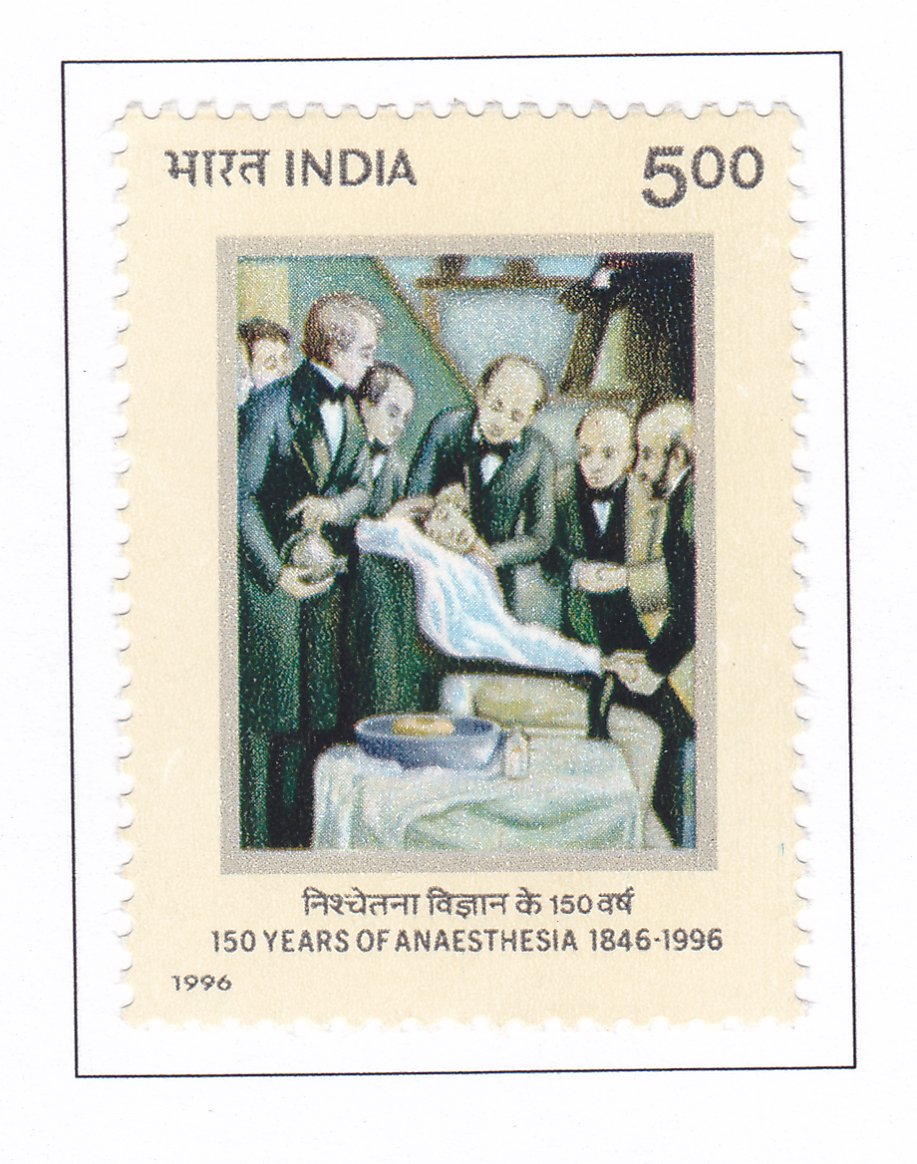150th Anniversary of Anaesthesia

Technical Data
| Date of Issue | December 27, 1996 |
|---|---|
| Denomination | Rs. 5 |
| Quantity | 700,000 |
| Perforation | comb 13 x 13½ |
| Printer | Security Printing Press, Nashik |
| Watermark | No Watermark |
| Colors | Multicolor |
| Catalog Codes |
Michel IN 1530 Stamp Number IN 1592 Yvert et Tellier IN 1297 Stanley Gibbons IN 1694 |
| Themes | Anniversaries and Jubilees | Healthcare | Medical Science | Physicians |
Table of Contents
Commemorative Stamp: 150 Years of Anaesthesia
Design Elements:
- Main Image: The stamp prominently features William Thomas Green Morton administering ether to Gilbert Abbott at the Massachusetts General Hospital. The depiction captures the historical moment of the first successful use of ether anesthesia in surgery, with surgeon John Collins Warren in the background, performing the tumor removal.
- Symbolic Elements: The background of the stamp subtly integrates the image of an operating room, with modern anesthetic equipment, representing the evolution of anesthesiology over the years. A symbolic representation of a heartbeat line transitioning from erratic to stable emphasizes the life-saving impact of anesthesia.
- Color Palette: The design uses a calming palette of blue and white, symbolizing the serenity and safety brought by anesthesia during surgical procedures. The use of gold highlights around the main figures represents the monumental significance of the discovery.
Cultural and Historical Significance:
- Historical Milestone: The discovery of anesthesia is one of the most important milestones in the history of medical science. It revolutionized surgery by allowing patients to undergo complex operations without experiencing pain, thereby saving countless lives.
- Evolution of Anesthesia: The stamp acknowledges the journey of anesthesiology from the use of ether to the introduction of chloroform and its eventual replacement with safer, more effective anesthetic agents. It highlights the global significance of anesthesia in making modern surgery possible.
- Indian Contribution: The reference to the Nizam of Hyderabad’s invitation to British commissions to study the safety of chloroform underscores India’s early involvement in the global advancement of anesthesiology. This historical connection adds depth to the significance of the stamp in the Indian context.
Usage:
- Postal Services: The stamp will be used in general postal circulation, raising awareness about the importance of anesthesia in medical science.
- Philatelic Collections: As a commemorative stamp, it holds value for collectors interested in medical history, significant scientific discoveries, and their impact on humanity.
- Educational and Medical Institutions: The stamp serves as a tool to educate the public and medical professionals about the historical development of anesthesia and its crucial role in modern medicine.
Importance of the Commemorative Stamp:
- Celebrating a Scientific Breakthrough: The stamp commemorates 150 years since the first successful use of anesthesia in surgery, marking a pivotal moment in medical history that transformed the practice of surgery and patient care.
- Recognizing Medical Pioneers: By featuring Morton and Warren, the stamp pays tribute to the pioneers who made painless surgery possible, acknowledging their contributions to the well-being of humanity.
- Highlighting Medical Advancements: The stamp draws attention to the advancements in anesthesiology that have enabled complex surgeries, such as open-heart surgery, neurosurgery, and organ transplants, which were once considered impossible.
Example of the Stamp Design:
- The design of the stamp captures the historic scene of the first use of ether anesthesia, with Morton administering the anesthetic and Warren performing surgery. The background includes modern surgical equipment, symbolizing the advancements in the field. The use of a heartbeat line transitioning from unstable to stable signifies the life-saving role of anesthesia.
The commemorative stamp might include:
- First Day Cover: The first day cover could feature an artistic representation of a surgical operating room from the 19th century, transitioning into a modern operating room, illustrating the progress in anesthesiology over the past 150 years.
- Informational Brochure: An accompanying brochure could provide details about the history of anesthesia, the challenges faced in its early use, the role of the Nizam of Hyderabad in studying chloroform’s safety, and the evolution of anesthetic techniques to the present day.
Significance:
- Honoring a Medical Revolution: The commemorative stamp honors the medical revolution brought about by the discovery of anesthesia, which continues to save lives and alleviate suffering in surgical procedures around the world. It serves as a reminder of the importance of scientific discovery and innovation in improving human health and well-being.
